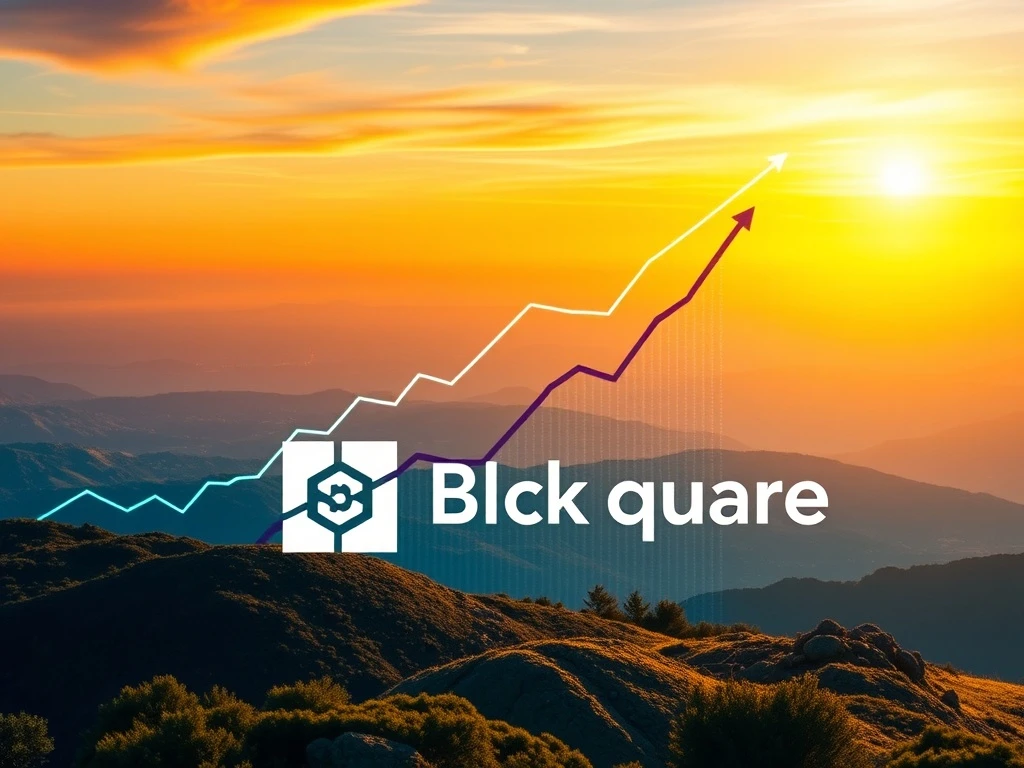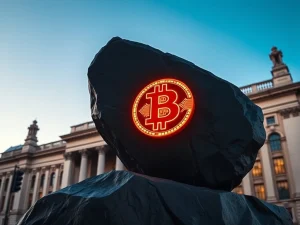Bitcoin News Today: Block’s Monumental S&P 500 Entry Amplifies Crypto Exposure, Stock Surges 14%

In a groundbreaking development for the cryptocurrency market and traditional finance alike, Jack Dorsey’s fintech powerhouse, Block Inc. (formerly Square), has officially joined the prestigious S&P 500 index. This isn’t just another corporate milestone; it’s a significant moment for Bitcoin News Today, marking Block as the third crypto-linked company to be included in the benchmark index, following Tesla and Coinbase. This inclusion, effective July 23, 2025, has sent ripples through the market, notably triggering a remarkable Block Stock Surge of 14% over five days in anticipation.
Block S&P 500 Inclusion: A Game Changer for Bitcoin Exposure?
Block’s entry into the S&P 500 isn’t merely about its market capitalization or earnings; it’s about the indirect yet substantial increase in Bitcoin Exposure for one of the world’s most influential stock indices. Replacing Hess Corp. after its $55 billion merger with Chevron, Block brings its significant Bitcoin holdings directly into the purview of passive index funds and institutional investors tracking the S&P 500.
Block’s balance sheet proudly holds 8,584 BTC, valued at approximately $1 billion at the time of the announcement, positioning it as the 13th-largest corporate Bitcoin holder globally. This move underscores a growing trend of institutional recognition for crypto assets as strategic reserves. For the first time, a major index like the S&P 500 is indirectly representing Bitcoin through the corporate treasuries of its constituents.
What Does Block’s S&P 500 Entry Signal?
The inclusion of Block, a company deeply intertwined with the Bitcoin ecosystem through its Cash App and TBD divisions, sends a powerful message:
- Legitimization of Crypto Holdings: It signals that holding Bitcoin as a treasury asset is no longer a fringe strategy but an increasingly accepted corporate finance decision, even for companies entering the most respected financial benchmarks.
- Increased Institutional Visibility: Millions of investors, often passively invested in S&P 500 index funds, now have indirect exposure to Bitcoin, whether they realize it or not. This could lead to broader acceptance and understanding of crypto assets.
- A Nod to Fintech Innovation: Block’s primary business as a fintech and payments company, alongside its crypto ventures, highlights the S&P 500’s evolving criteria to include companies at the forefront of financial technology and digital assets.
The Block Stock Surge: What’s Driving the Momentum?
The 14% Block Stock Surge in the days leading up to its S&P 500 debut wasn’t just speculative trading; it reflects a deeper institutional interest. Analysts attribute this momentum to several factors:
- Anticipated Index Fund Inflows: When a company joins the S&P 500, index funds tracking the benchmark are mandated to purchase its shares, creating immediate buying pressure.
- Heightened Crypto Interest: With Bitcoin’s price stabilizing near $118,500 amidst increased regulatory clarity and accumulation by conservative entities, Block offers a more traditional, regulated pathway for institutions to gain indirect crypto exposure.
- Strategic Positioning: As an crypto-linked company, Block is seen as well-positioned to capitalize on the ongoing mainstream adoption of digital payments and cryptocurrencies.
An X post from OnlyCalls aptly summarized the sentiment, noting that the inclusion “solidifies BTC’s financial visibility” and could encourage more traditional firms to adopt Bitcoin as a treasury asset. This highlights the dual role Block plays: a fintech innovator and a significant Bitcoin custodian.
Comparing Crypto-Linked Companies in the S&P 500
Block isn’t alone in its crypto ties within the S&P 500. Let’s compare its trajectory with the other two notable crypto-linked company giants:
| Company | Primary Business | BTC Holdings (Approx.) | Recent Stock Performance (Past Month) | Key Driver for Performance |
|---|---|---|---|---|
| Block (SQ) | Fintech, Payments (Cash App, Square) | 8,584 BTC ($1B) | +14% (5 days post-announcement) | S&P 500 inclusion, Bitcoin exposure |
| Coinbase (COIN) | Cryptocurrency Exchange | 9,267 BTC | +28.4% | Broader crypto market rally, regulatory clarity |
| Tesla (TSLA) | Electric Vehicles, Energy | 11,509 BTC | -4.6% | Operational challenges, market competition |
These variations underscore the nuanced interplay between crypto holdings and corporate fundamentals. While Coinbase’s shares soared, largely mirroring the broader crypto market’s 23% gain, Tesla’s decline is attributed to operational challenges rather than its crypto-specific factors. This shows that while Bitcoin Exposure is a factor, a company’s core business performance and sector-specific challenges remain paramount.
Navigating the New Dynamics: Risks and Opportunities
The S&P 500’s inclusion criteria—requiring a market cap over $18 billion, positive earnings, and a public float above 10%—ensure only established firms enter the index. However, their crypto exposures introduce new dynamics for index-linked portfolios.
Potential Benefits:
- Mainstream Validation: Block’s inclusion further validates Bitcoin’s role in corporate treasuries and as a legitimate asset class.
- Diversification (Indirect): For traditional investors, it offers a subtle, indirect way to gain exposure to the crypto market without directly buying volatile digital assets.
- Catalyst for Adoption: It could encourage more traditional firms to explore Bitcoin as a treasury asset, seeing its acceptance within a major index.
Potential Challenges and Risks:
- Volatility Transmission: The inclusion exposes the S&P 500 to the inherent volatility of crypto markets, potentially affecting index performance during sharp crypto downturns.
- Investor Awareness: Many investors in S&P 500 funds may be unaware of their newfound indirect Bitcoin Exposure, which could lead to unexpected portfolio fluctuations.
- Regulatory Scrutiny: As more crypto-linked companies enter mainstream indices, regulatory bodies might increase their scrutiny of corporate crypto holdings and related activities.
The S&P 500’s staggering $50 trillion market capitalization now indirectly reflects Bitcoin through firms like Block, potentially amplifying exposure for institutional investors. However, the long-term success of this inclusion hinges on Block’s ability to balance innovation with regulatory compliance and investor expectations.
The Future of Bitcoin in Traditional Finance
As Jack Dorsey’s vision of Bitcoin’s mainstream adoption faces increasing scrutiny and opportunity, Block’s performance in the S&P 500 will be closely watched. It could signal whether traditional markets definitively view crypto as a strategic asset or a speculative liability. This pivotal moment, extensively covered in Bitcoin News Today, reinforces the ongoing convergence of decentralized digital assets and established financial systems.
For investors, this development highlights the importance of understanding the underlying assets of the companies within their portfolios. The Block Stock Surge is a testament to the market’s enthusiasm, but a holistic view of Block’s business, including its Bitcoin strategy, will be crucial for informed decisions going forward. This is more than just a stock market event; it’s a testament to Bitcoin’s undeniable march into the mainstream.
Frequently Asked Questions (FAQs)
Q1: What does Block’s inclusion in the S&P 500 mean for Bitcoin?
A1: Block’s inclusion significantly increases the S&P 500’s indirect exposure to Bitcoin. As Block holds a substantial amount of BTC on its balance sheet, investors in S&P 500 index funds now have a passive, indirect stake in Bitcoin, further legitimizing its role as a corporate treasury asset.
Q2: How many crypto-linked companies are now in the S&P 500?
A2: With Block’s addition, there are now three prominent crypto-linked companies in the S&P 500: Block (SQ), Coinbase (COIN), and Tesla (TSLA). Each holds significant Bitcoin reserves or has direct business ties to the crypto industry.
Q3: Why did Block’s stock surge after the S&P 500 announcement?
A3: The Block Stock Surge of 14% was primarily driven by anticipated inflows from S&P 500 index funds, which are required to buy shares of newly added companies. Heightened institutional interest in crypto and Block’s strategic positioning in fintech also contributed to the momentum.
Q4: Does Block’s S&P 500 entry expose investors to crypto volatility?
A4: Yes, indirectly. While Block is a traditional stock, its significant Bitcoin holdings mean that the company’s performance, and by extension the S&P 500’s, could be influenced by the inherent volatility of the crypto market. This introduces new dynamics for investors.
Q5: What are the S&P 500’s criteria for company inclusion?
A5: To be included in the S&P 500, a company typically needs a market capitalization of over $18 billion, positive reported earnings in the most recent quarter and over the past four quarters combined, and a public float of at least 10% of its shares.
Q6: What are the broader implications for traditional finance?
A6: Block’s inclusion signifies a growing convergence between traditional finance and the crypto ecosystem. It suggests that major indices are adapting to include companies that embrace digital assets, potentially paving the way for more direct crypto integration and broader institutional adoption in the future.









